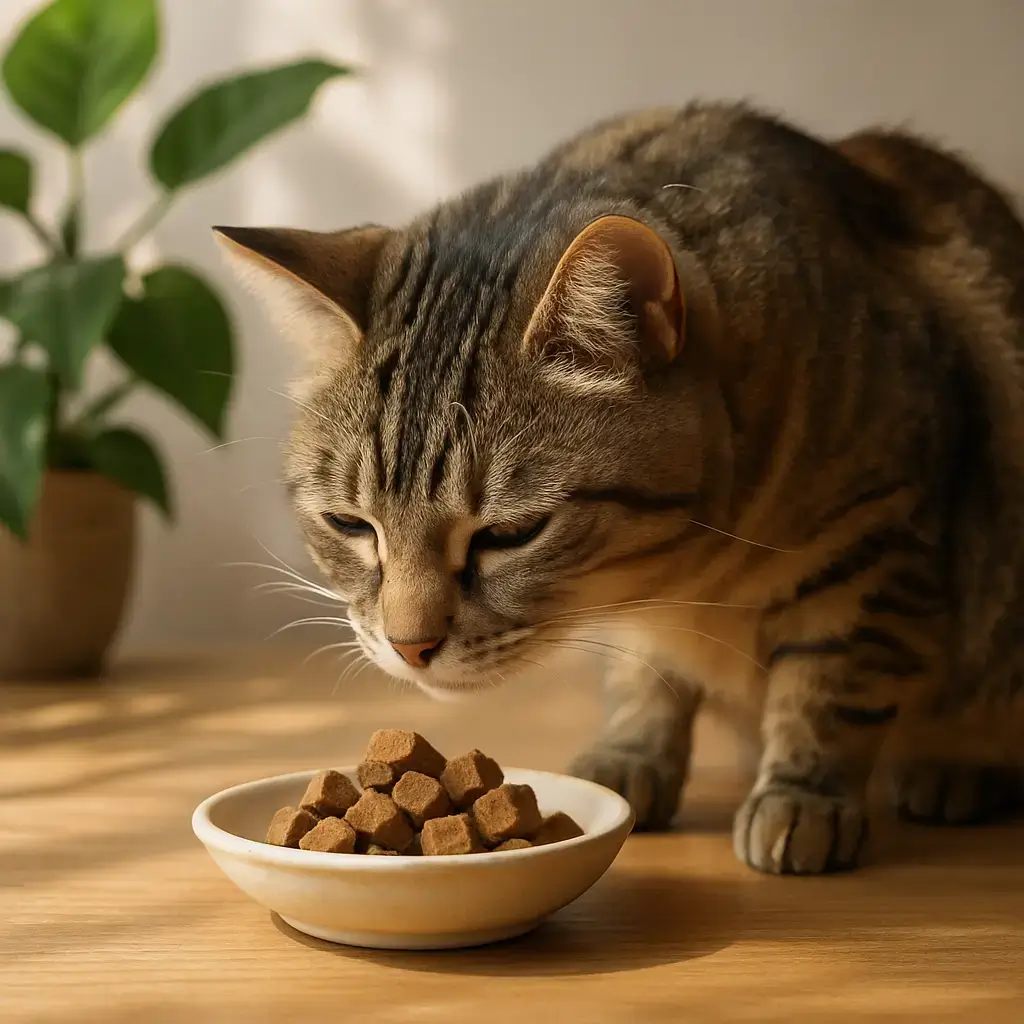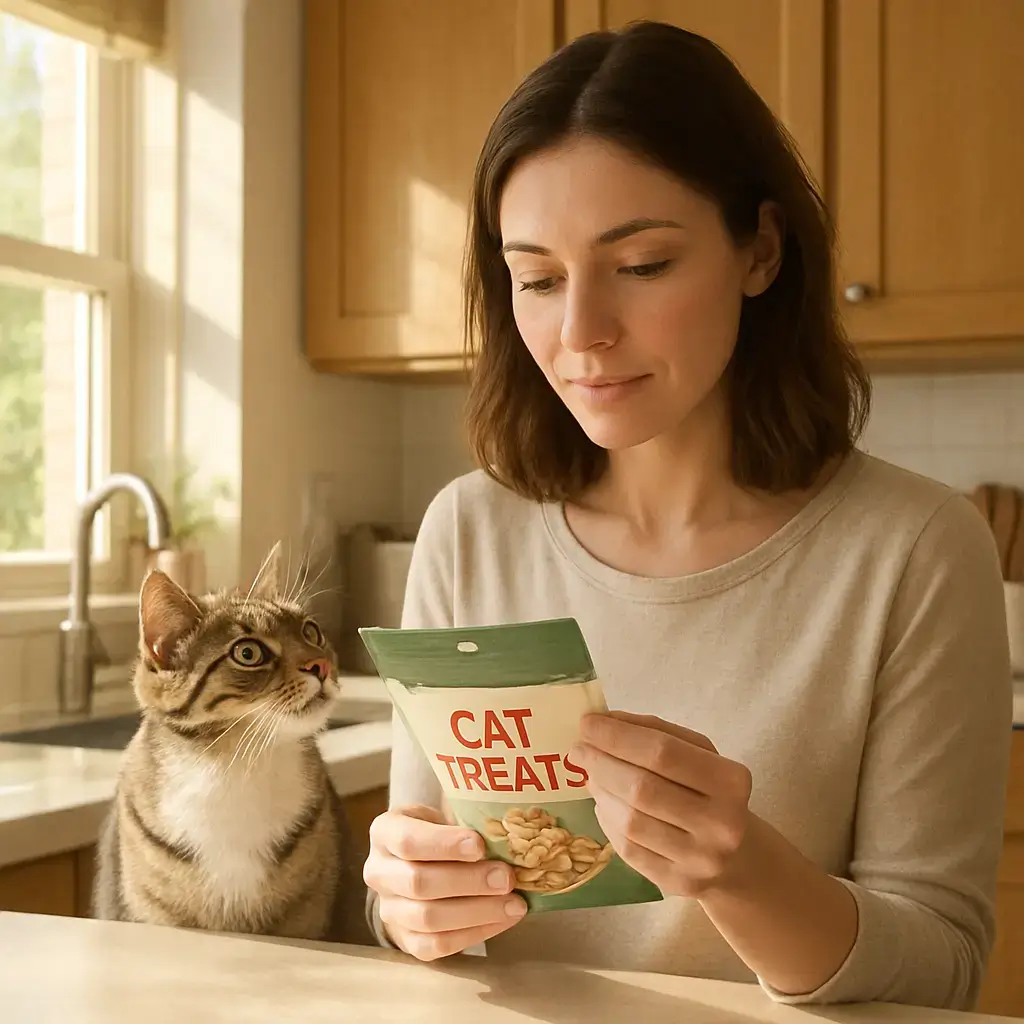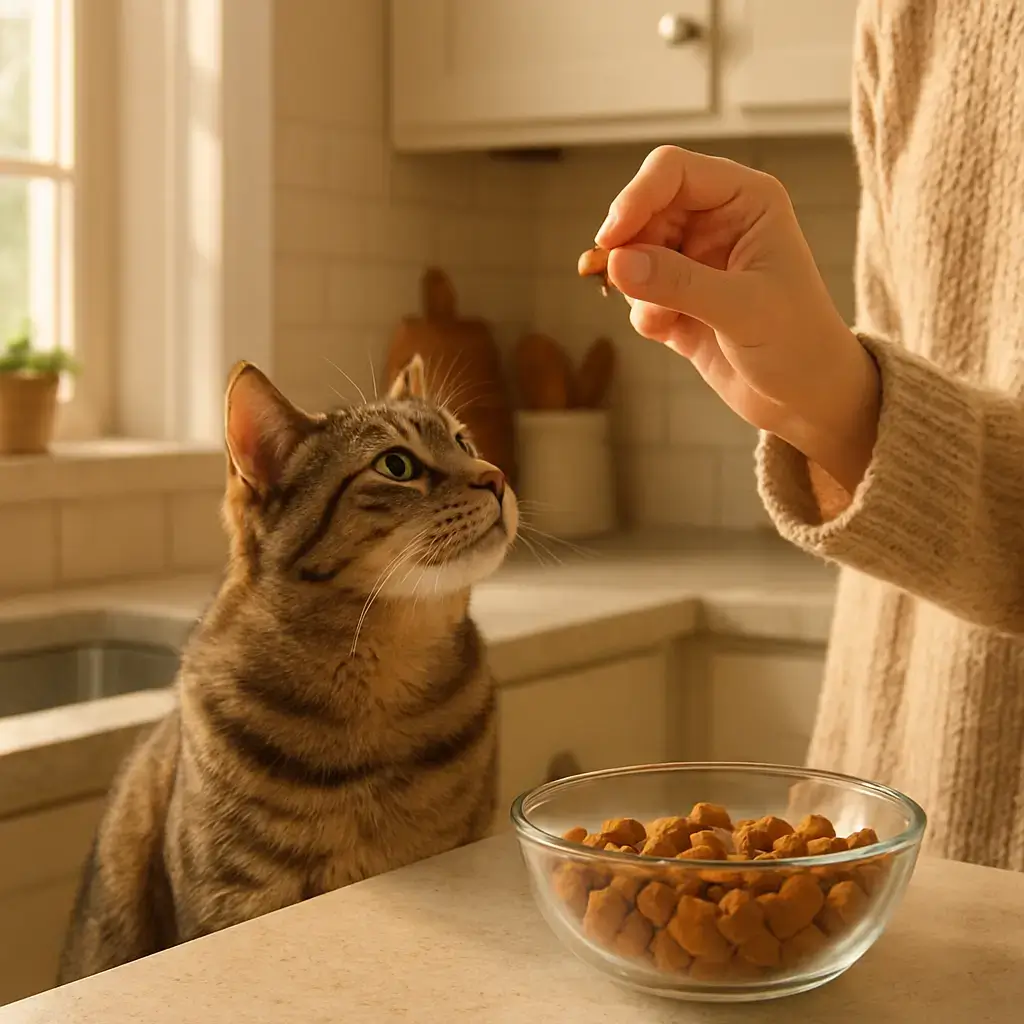Healthy cat treats can be a joyful part of your daily bond with your feline friend. Choosing them with care also supports essential cat nutrition and reinforces your commitment to their wellbeing. Many pet parents find this small gesture speaks volumes.
Not all treats are created equal, though. Those made with simple, digestible ingredients and aligned with your cat’s unique needs can be gentle on sensitive stomachs while complementing their overall feline dietary needs. What you pick—and what you avoid—matters more than most realize.
Experts often note that treats should always serve your cat’s health as much as their delight. From training routines to quiet cuddle time, wholesome snacks let you nurture without worry. A mindful approach keeps their regular meals balanced and beneficial.
As we explore which ingredients and types of nutritious cat treats best support your cat’s needs and preferences, you’ll gain confidence in every choice you make.
Understanding Cat Treat Nutrition

It’s easy to get swayed by flavor or packaging, but nourishing your cat means looking deeper. Understanding the benefits of healthy cat treats in a balanced diet helps you choose snacks that truly support their well-being—rather than just pleasing their palate.
Key nutrients in cat snacks
Your cat needs certain nutrients in every meal—including treats—to thrive. These include taurine (an essential amino acid), animal-based protein, and healthy fats. Treats that include real chicken, turkey, or fish often deliver these nutrients better than grain-heavy or filler-packed alternatives.
Watch for added vitamins and minerals, like vitamin E and biotin. These support skin, coat, and immune health—just like how daily supplements benefit humans when whole food is limited. When possible, avoid artificial colors or sweeteners that offer no value to feline dietary needs.
AAFCO nutritional guidelines
The Association of American Feed Control Officials (AAFCO) provides nutrient profiles for pet food, including snacks. While treats don’t have to be “complete and balanced,” some follow AAFCO guidelines to support good cat nutrition alongside meals. These treats are more likely to complement—not disrupt—your cat’s main diet.
Treat packaging may say “intended for supplemental feeding only,” which means it adds nutritional value but shouldn’t replace meals. This matters especially if your cat has dietary sensitivities or needs weight control support.
Why balance matters in treats
Too many treats—even nutritious ones—can throw off your cat’s daily intake. This makes portion control and ingredient awareness key. A wellness-forward approach means choosing snacks that align with your cat’s age, activity level, and digestion comfort.
Including wellness cat treats as part of their overall plan can make moments of bonding also moments of benefit. It’s these small, mindful choices that stack up to build a healthier routine.
As you explore treat labels or recipes, it helps to know what truly fuels your cat. Next, we’ll look at what to watch out for—especially when treat ingredients may do more harm than good.
Ingredients to Avoid in Cat Treats
Once you’ve grasped your cat’s nutritional basics, it becomes easier to spot ingredients that don’t belong. Many commercial treats sneak in fillers or chemicals that don’t support your cat’s health or may irritate sensitive tummies. That’s why it’s worth learning how to find cat treats without harmful additives or fillers.
Artificial preservatives and colors
Chemicals like BHA, BHT, and ethoxyquin are often found in pet treats to preserve shelf life. However, experienced practitioners often suggest avoiding these when possible. Artificial colorings like Red 40 or Yellow 5 don’t bring any nutritional value and may contribute to food sensitivities in some cats.
Red flag filler ingredients
Filler ingredients offer little to no nutritional benefit. Corn gluten meal, wheat middlings, and soy by-products are commonly used to bulk up treats cheaply. Cats, being obligate carnivores, thrive on proteins—not grains. Opting for options free from such excess fillers supports healthier digestion and aligns with feline dietary needs.
how additives affect digestion
Repeated exposure to artificial ingredients can upset your cat’s stomach or cause irregular stools. Some low-cost treats even contain binding agents that are hard for pets to break down. Many readers report improvements when switching to no artificial ingredients pet treats, especially cats with chronic digestive troubles.
When you select natural cat snacks made with transparency and care, you’re choosing wellness over compromise. As we move forward, we’ll explore how to read treat labels with confidence so your choices better support a safe and sensible routine.
How to Read Cat Treat Labels

It’s easy to feel overwhelmed when flipping over a package of treats. But learning to read pet food labels helps protect your cat’s wellbeing and removes the guesswork. This section gently walks you through how to choose healthy cat treats for daily rewards by focusing on the language used on packaging and ingredient lists.
Identify first ingredients
Look for treats that list a named animal protein—like chicken, turkey, or salmon—as the first ingredient. This tells you the snack is built on natural cat food ingredients that support your cat’s need for high-quality protein. Vague terms like “meat by-products” offer less clarity and may mean lower nutritional value. Short ingredient lists often point toward more natural, nutrient-familiar recipes.
Spot unnecessary fillers
Many treats include “fillers,” which are non-nutritive bulk ingredients added to improve shelf life or texture. These might include cornmeal, soy, or wheat gluten. While not always harmful, fillers don’t offer much to a balanced feline diet and can sometimes upset sensitive stomachs. Labels that minimize starches and prioritize limited, recognizable ingredients may better match your cat’s natural digestive patterns.
Label tips for sensitive cats
If your cat has food sensitivities or a delicate tummy, check for terms like “limited ingredient,” “single protein source,” or “grain-free.” While not a guarantee of safety, they may suggest the treat is more likely to be gentle. Cat parents often find that natural cat snacks with fewer additives and no artificial preservatives cause fewer issues day-to-day.
Taking a moment to review labels can help you make more conscious choices—ones that better support your cat’s health and enjoyment. As you keep learning, this label awareness pairs well with thoughtful portions and mindful treat routines.
Healthy Cat Treats for Weight Control

After understanding how to read cat treat labels, a natural next question is how much and how often you can offer these rewards—especially if your cat is carrying extra weight. The right snack won’t sabotage their progress. Instead, it can be a gentle part of your cat’s weight-aware routine.
Safe daily calorie ranges
Most healthy cat treats for weight management contribute only a small portion of your cat’s daily calorie intake. Many cat parents follow the general guideline: treats should account for no more than 10% of your cat’s total daily calories. For an average indoor cat, this means around 15–20 calories from treats. Always adjust based on your vet’s recommendations and your cat’s size and activity level.
Treat sizes vs. servings
It’s not just what your cat eats but how much. Portion control—deciding how many pieces make a proper snack—matters more than you might think. A single large treat could equal several smaller, low calorie cat snacks. Use the label’s serving size (the suggested amount per day) to guide you, but observe how your cat responds and adjust gently.
Weight-conscious treat timing
Spreading treats throughout the day can provide bonding moments without overwhelming your cat’s diet. Experienced practitioners suggest offering rewards during training, grooming, or interactive play—when your cat is alert and active. This supports cat obesity prevention tips without skipping the joy of a shared snack.
Low fat cat treats, when chosen thoughtfully, let you support weight care and still celebrate your cat’s wins. Next, we’ll explore wellness-focused snacks that add a little nutrition to those affectionate moments, too.
Wellness Benefits in Natural Cat Treats
Once your cat is enjoying low-calorie treats safely, it’s helpful to explore options that boost their overall well-being. Nutritious cat snacks that support feline wellness often provide more than just a quick nibble—they can fortify daily health routines in gentle, effective ways.
Treats made from high-quality animal proteins like chicken or salmon help maintain muscle tone and energy. When paired with natural ingredients your cat’s system recognizes, they can be easier to digest and less likely to cause stomach upset. Many pet parents find that digestive-friendly cat snacks sit better with sensitive tummies, especially when they’re free of artificial fillers.
Look for wellness-focused treats that include functional nutrients such as omega-3 fatty acids, which are known to support coat shine and joint flexibility. A high protein cat snack may also have moisture-rich components or natural fiber to support healthy digestion—a small but meaningful boost alongside their main meals.
Organic cat treats can be a lovely way to offer enrichment while feeling confident about what you’re feeding. When you’re mindful of how often and what you offer, these snacks can encourage bonding, mental engagement, and joyful moments without displacing a balanced diet.
If your cat enjoys time indoors, you’ll soon discover a variety of treat formats that fit easily into your daily routines—from portable bites to crumbled toppers designed for play and interaction.
Healthy Daily Cat Treat Ideas

Supporting your indoor cat’s nutrition through mindful treats can feel both rewarding and relaxing. Many pet parents look for healthy daily treat ideas for indoor cats that fit naturally into their companion’s routine. You’ll discover there are gentle, simple options—ones that bring flavor and nutrition in equal measure.
Freeze-dried choices
Freeze-dried treats are made by drying raw ingredients gently at low temperatures, preserving most of the nutrients. These can include pieces of chicken, salmon, or liver—foods your cat instinctively enjoys. Many readers report these feel like a special snack, yet they’re clean, single-ingredient options high in protein. Just be sure to give small portions.
Grain-free soft chews
Grain-free healthy treats for cats often skip common fillers like wheat, corn, and soy. Instead, they rely on sweet potatoes, peas, or chickpeas as their base. In soft-chew form, they’re easier for seniors or sensitive-mouth kitties to enjoy daily. Some even include calming herbs or dental support—but always check for natural preservatives.
DIY healthy options
DIY (do-it-yourself) treats give you full control over what goes in. Boiled chicken cubes, steamed carrots, or even unsalted sardine flakes can offer variety. Most indoor cat parents find these low calorie pet treats useful for bonding or rotation. Keep cooked portions tiny and refrigerate any extras safely.
With a little curiosity and care, you’ll find healthy kitty treats that complement your cat’s day beautifully—backed by heart, not hype.
Frequently Asked Questions
What ingredients make cat treats healthy?
Healthy cat treats typically include high-quality animal proteins like chicken or salmon, which align with feline dietary needs. Look for limited ingredients without artificial additives, fillers, or added sugars—common triggers for digestive upset. Low calorie cat snacks are often recommended for weight control, especially in indoor or less active cats. Many wholesome cat snacks also avoid grains and instead use natural cat food ingredients such as sweet potato or pumpkin. Choosing treats with simple, clean labels helps you support your cat’s overall wellness without compromising their balanced feline diet.
How often can I safely give my cat treats?
A common approach is to limit treats to no more than 10% of your cat’s daily calories. This helps maintain a balanced feline diet without disrupting their regular food intake. Treats are best used thoughtfully—for training, bonding, or as a gentle reward for good behavior. Choosing low calorie cat treats can support wellness while preventing unwanted weight gain over time. Trust your rhythm and your vet’s guidance—healthy treats are a loving bonus, not a daily must.
Why is it important to choose natural cat treats?
Choosing natural cat treats supports your cat’s health by avoiding artificial preservatives, flavor enhancers, and fillers that can upset sensitive systems. Natural treats often rely on limited, easily digestible ingredients—like single-source proteins or gentle vegetable bases—making them a gentler option for daily snacking. This helps maintain a balanced feline diet while reducing the risk of digestive issues. A common approach is to seek options labeled grain-free or with no artificial ingredients. Trust grows when you feel confident that what you’re offering supports your cat’s wellness, not just their cravings.
Which cat treats help with weight control?
Cat treats that support weight control are typically low calorie and packed with lean protein. A common approach is to offer high protein cat snacks that fill your kitty up without excess fat. Look for labels that say “grain free healthy treats for cats” or “low calorie cat treats,” and avoid added sugars or fillers. Many experienced practitioners suggest choosing treats made with single natural ingredients, like freeze-dried chicken. Small portions help your cat feel rewarded without tipping their daily intake—especially important for feline obesity prevention.
Are chicken liver treats safe for all cats?
Chicken liver treats are generally safe when offered in moderation, but not all cats tolerate them equally well. These high protein cat snacks can be rich in nutrients like vitamin A, which is essential—but too much may upset a balanced feline diet if given too often. For cats with sensitive stomachs or dietary conditions, it’s best to introduce liver treats slowly and watch for any digestive changes. A common approach is to use them as occasional rewards, not daily staples. Always consult your vet if you’re unsure about your cat’s individual needs.
Choose Treats That Reward and Reassure
Whether it’s a soft chew or a freeze-dried bite, your daily treat choices matter. Trust grows in the small routines—especially when you’re balancing flavor and your cat’s well-being. Choosing healthy cat treats is more than simple reward; it’s a quiet yes to the long-term care they deserve. When treats fit their feline dietary needs, you’re nurturing moments that feel both joyful and safe.
Many find reassurance in knowing their choices echo expert wisdom and respect their cat’s natural rhythm. Thoughtful options—like wholesome cat snacks—can help support cat nutrition without overcomplicating your routine. Small effort, lasting care. You’re doing beautifully.